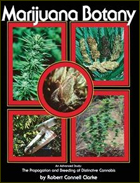
by Robert Connell Clarke
Making an Air Layer
A recently sexed young limb 3-10 mm (1/8 to 3/8 inch) in diameter is selected. The site of the layer is usually a spot 30 centimeters (12 inches) or more from the limb tip. Unless the stem is particularly strong and woody, it is splinted by positioning a 30 centimeter (12 inch) stick of approximately the same diameter as the stem to be layered along the bottom edge of the stem. This splint is tied in place at both ends with a piece of elastic plant-tie tape. This enables the propagator to handle the stem more confidently. An old, dry Cannabis stem works well as a splint. Next, the stem is girdled between the two ties with a twist of wire or a diagonal cut. After girdling, the stem is sprayed or dusted with a fungicide and growth regulator, surrounded with one or two handfuls of unmilled sphagnum moss, and wrapped tightly with a small sheet of clear polyethylene film (4-6 mil). The film is tied securely at each end, tightly enough to make a waterproof seal but not so tight that the phloem tissues are crushed. If the phloem is crushed, compounds necessary for rooting will accumulate outside of the medium and rooting will be slowed. Plastic florist’s tape or electrician’s tape works well for sealing air layers.
Although polyethylene film retains moisture well, the moss will dry out eventually and must be remoistened periodically. Unwrapping each layer is impractical and would disturb the roots, so a hypodermic syringe is used to inject water, nutrients, fungicides, and growth regulators. If the layers become too wet the limb rots. Layers are checked regularly by injecting water until it squirts out and then very lightly squeezing the medium to remove any extra water. Heavy layers on thin limbs are supported by tying them to a large adjacent limb or a small stick anchored in the ground. Rooting begins within two weeks and roots will be visible through the clear plastic within four weeks. When the roots appear adequately developed, the layer is removed, carefully unwrapped, and transplanted with the moss and the splint intact. The layer is watered well and placed in a shady spot for a few days to allow the plant to harden-off and adjust to living on its own root system. It is then placed in the open. In hot weather, large leaves are removed from the shoot before removing the layer to prevent excessive transpiration and wilting.
Layers develop fastest just after sexual differentiation. Many layers may be made of staminate plants in order to save small samples of them for pollen collection and to conserve space. By the time the pollen parents begin to flower profusely, the layers will be rooted and may be cut and removed to an isolated area. Layers taken from pistillate plants are used for breeding, or saved and cloned for the following season. Layers often seem rejuvenated when they are re moved from the parent plant and begin to be supported by their own root systems. This could mean that a clone will continue to grow longer and mature later than its parent under the same conditions. Layers removed from old or seeded parents will continue to produce new calyxes and pistils instead of completing the life cycle along with the parents. Rejuvenated layers are useful for off-season seed production.

